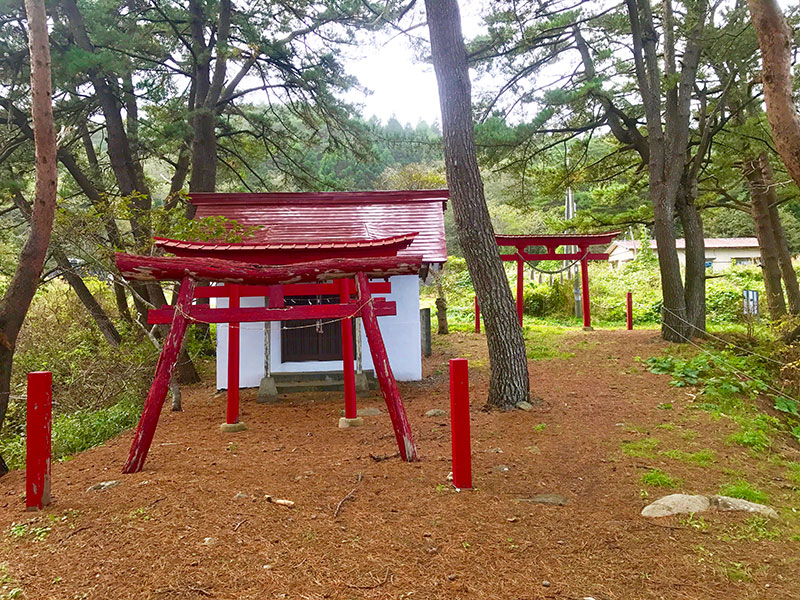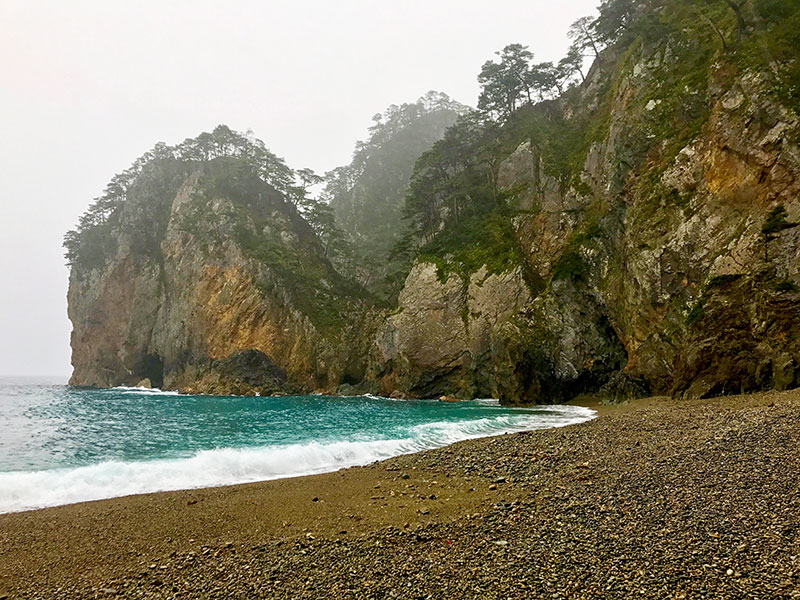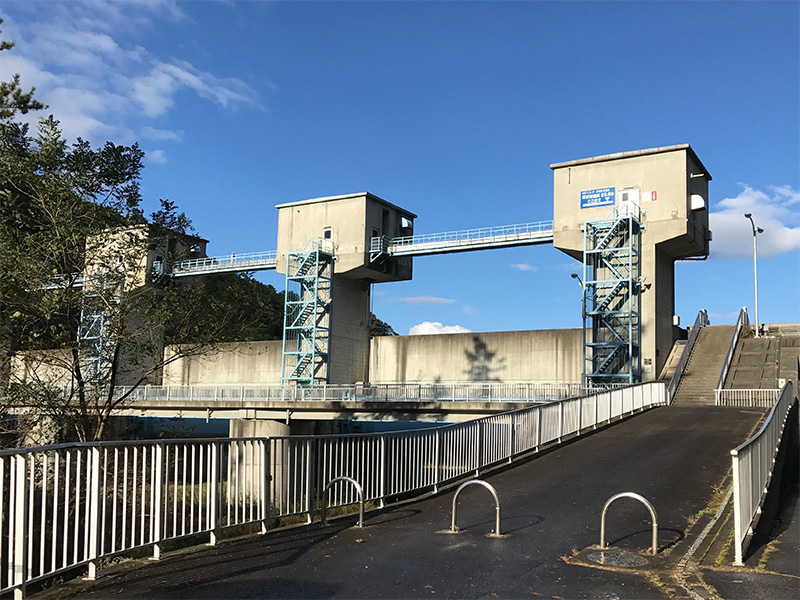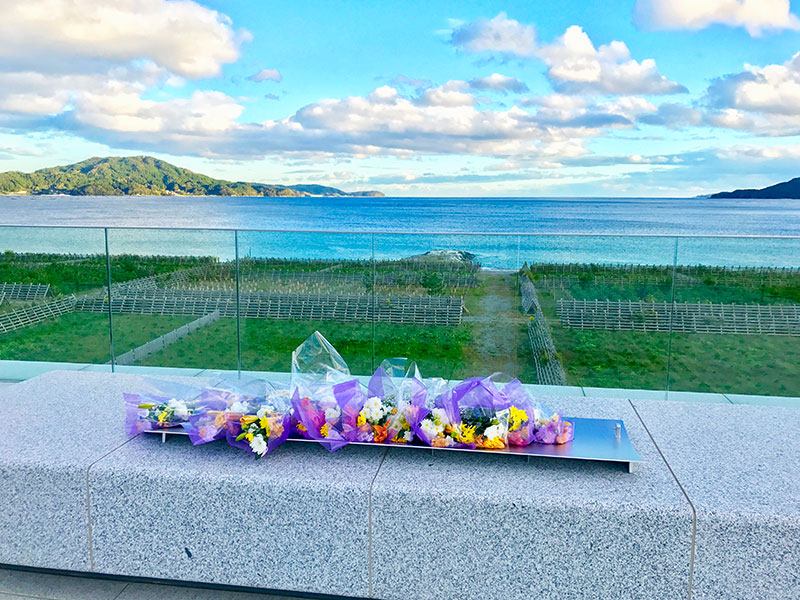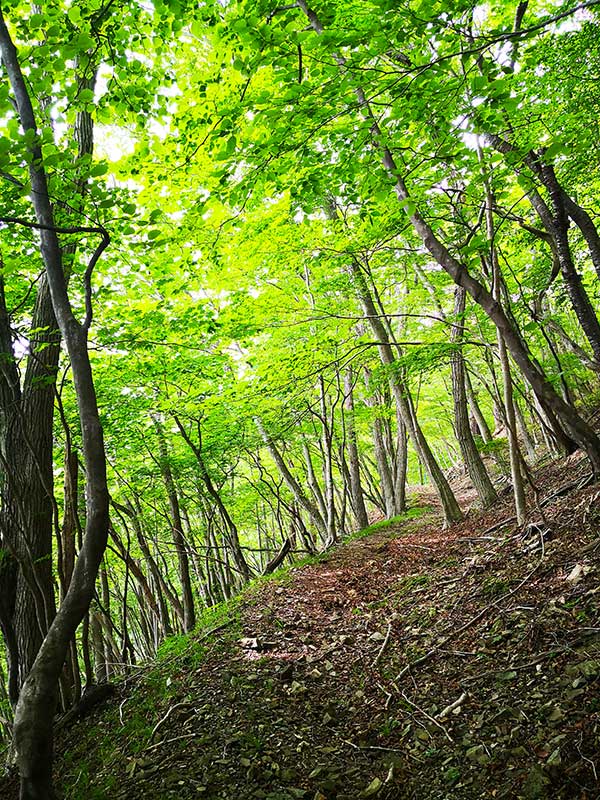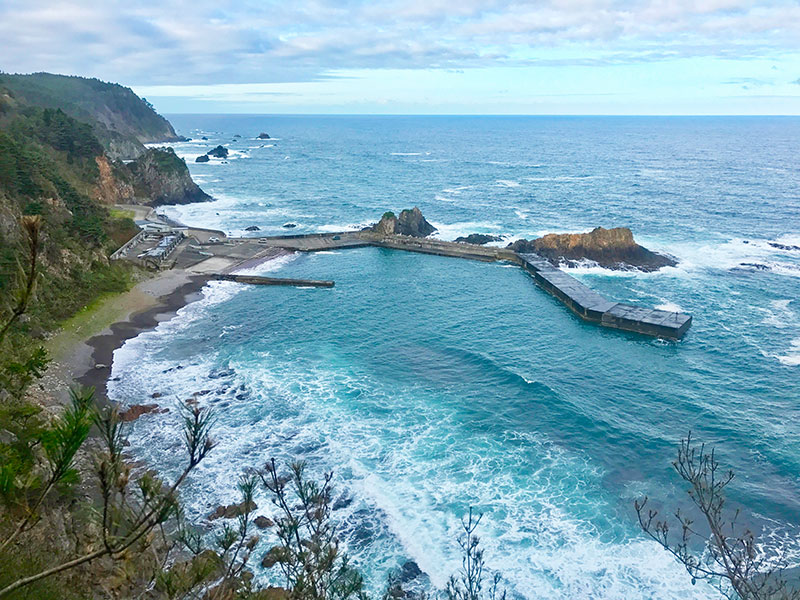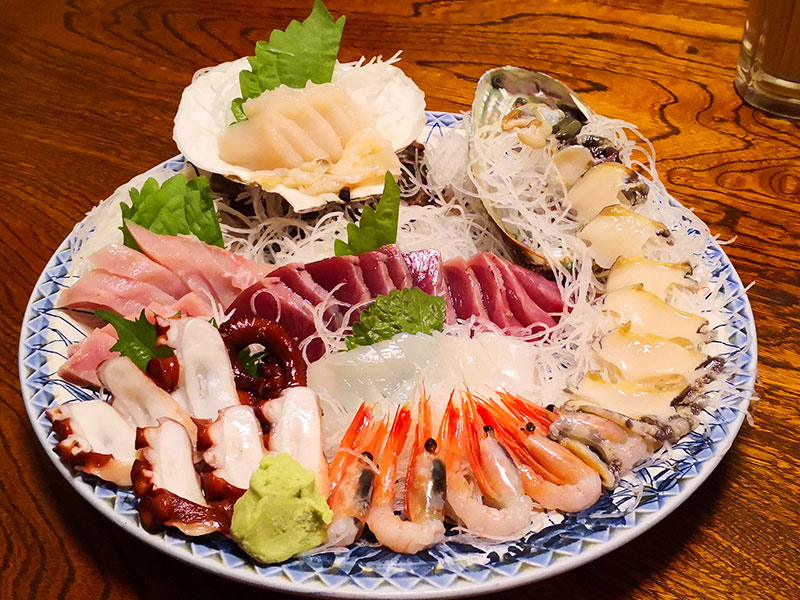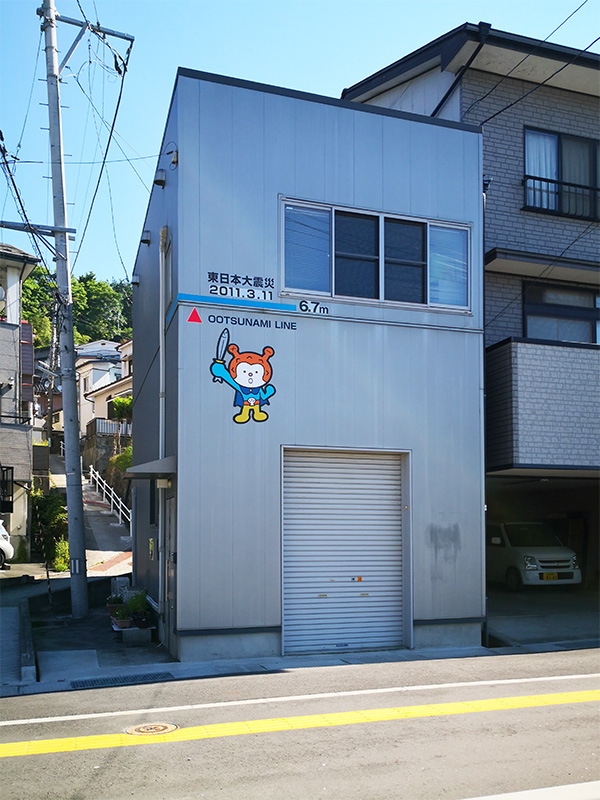A self-guided walking tour along the Michinoku Shiokaze Coastal Trail in Japan’s Tohoku region.
Self-guided version of Walk Japan’s Michinoku Coastal Trail in Japan’s Tohoku region. Delightful walks in remote countryside from beaches to cliff tops and through coastal communities. Spectacular views over the Pacific Ocean and intricately carved coastline. Beautifully located accommodation mostly overlooking the sea, bountiful seafood cuisine.
April - June & September - November.
The Michinoku Coastal Wayfarer is a 10-day, 9-night tour starting in Hachinohe and finishing in Kesennuma. Accommodation is in Japanese-style hotels and inns. Please read more on accommodation here. For more information please contact us.
Walk Japan’s Michinoku Coastal Wayfarer Self-Guided Tour explores the Michinoku Shiokaze Coastal Trail, a long distance footpath following the spectacular Sanriku Coast in Japan’s northern Tohoku region. Tohoku is beautiful, rugged, remote and, aside the Pacific Ocean, bountiful. For centuries the rich fishing found in the seas here has been the backbone of the local economy. Infrequently, however, the same seas also have a ravaging effect on local communities, most recently in March 2011 when a series of tsunami swept over the length of the coastline.
The Michinoku Coastal Wayfarer was developed from The Michinoku Shiokaze Coastal Trail, which was established as part of the Tohoku reconstruction efforts. Its officially stated objectives include the enjoyment of beautiful sights and natural landscapes; to welcome all who love to walk and bring about connections between locals and visitors; and to memorialise the kindness and harshness of nature including the events of 2011. And, it does all this exceedingly well.
The Michinoku Shiokaze Coastal Trail begins in Hachinohe, a pleasant regional city in Aomori Prefecture, and follows the Sanriku Coast to Soma in Fukushima Prefecture some 1,025 kilometres (637 miles) to the south. Walk Japan’s Michinoku Coastal Wayfarer focuses on the northern section between Hachinohe and Kesennuma, a vibrant fishing port in Miyagi Prefecture. Never far from the Pacific Ocean this tour is roughly divided between the northerly rugged and the more southerly intricate ria coastlines. The trail weaves its way over grassy promenades, to isolated beaches and coves, up and along towering clifftops, via rural Shinto shrines, through small quiet fishing and farming villages, and onto larger towns such as Miyako, Ofunato and Kesennuma. Some of these communities were little touched by the dramatic events of 2011 while in others the work of reconstruction is only just coming to an end.
The contrast between the tsunami’s destructive power and the sheer scale of the damage they caused with what has been achieved over the subsequent ten years in rebuilding is certainly memorable; something to appreciate alongside the region's natural beauty and rich seafood culture. Perhaps, however, the most extraordinary experience is seeing the locals' positiveness, vigour, generosity and warmth shown to everyone.
Your travels are on foot, on local trains and by private hire vehicles. On your way you visit some of the most picturesque natural sights in Japan including classic pine tree coastlines, atmospheric Shinto shrines and Jodogahama, cliffs of brilliant white sandstone set in limpid emerald seas. The natural world abounds and with luck you may spy soaring ospreys or, more likely, a placid serow, a goat-antelope like animal.
Off the Sanriku Coast are some of the richest fishing grounds found anywhere in the world and not surprisingly, seafood is a significant part of the local diet. For lovers of walking and fish-based cuisine the Wayfarer Michinoku Coastal Trail is an ideal tour. Meals will vary according to season but will include a variety of local seafood such as abalone, oysters, clams, salmon, and squid. The majority of our accommodation is aside the ocean and incorporates baths overlooking the sea for a delightful and leisurely way to relax before evening feasts. Good weather willing, early risers can also watch glorious sunrises over the Pacific Ocean while enjoying a reviving morning soak.
The route includes undulating forest terrain and some steeper sections. The tour materials provided, including the route booklet, fully complement this tour and are based on Walk Japan's extensive research of the Tohoku area and its expertise derived from over 30 years of leading guided walking tours throughout Japan.
A Level 4 tour, the daily distances walked on the Michinoku Coastal Wayfarer tour are between 10–15km (6.2–9.4 miles) and elevation gain between 150–500m (492–1,641ft). Options may be provided to lengthen or shorten each day’s itinerary to suit your energy levels. There are some ascents on well-maintained forest trails and also some steep flights of steps. Your main luggage is transferred for you between each day’s accommodation. Also included in the tour are four transfers by private vehicle to the start and from the end of more remote walking trails.
What is included?
A pre-tour pack. The pack includes details on how to prepare for your Wayfarer Tour, how to travel from your arrival point in Japan to the accommodation at the start of your tour, weather advice, checklist, etc. The pack also includes details on exploring places of interest while travelling to Hachinohe, if you wish to do so. Upon receipt of a completed manifest form, your pre-tour pack will be made available for online viewing approximately two months prior to the start date of your tour. It can also be downloaded as a PDF file for offline use.
A Wayfarer Route Booklet. This is provided on arrival at your first night’s accommodation, and is an easily portable booklet. This includes detailed walking directions and logistical information, including maps, photographs and site-specific information such as lunch/cafe recommendations, museum/gallery recommendations and historical points of interest. A rain-resistant pouch and shoulder strap are also provided for ease of carrying the booklet while walking.
Click here for a sample of the Wayfarer booklet.
9-nights’ accommodation, 9 breakfasts, 2 lunches and 7 dinners.
Main baggage transfer between accommodation.
Four private vehicle transfers.
In-country (Japan), 24-hour English-language emergency support.
What is not included?
Not included are flights, lunches and drinks with meals, two dinners and transfers other than those noted in the itinerary.
Please note that Wayfarer self-guided tours sometimes require transfers by public buses and/or trains that are not included in the tour price. This is either because it is not possible to reserve them in advance or to allow maximum flexibility for tour participants. Please contact us for further details.

At the end of the tour, please note that the travel time by train to both airports can take up to 5.5 hours.
Please note that on the morning of Day 6, your main baggage will be shipped in advance overnight to your accommodation on Day 7. On this day, you will need to carry all items you require overnight and your daypack should be sufficiently large to accommodate these items.
Day 1 Hachinohe
Hachinohe, a compact seafaring city, marks the northerly start point of the Michinoku Shiokaze Coastal Trail. Tour accommodation is in Hon-Hachinohe, which is a short local train journey from Hachinohe Station which is on the JR shinkansen line. A good evening meal can be enjoyed in one of the many restaurants found here.
Accommodation: Western-style hotel.
Meals: N/A.
Total walking: N/A.
Total elevation gain: N/A.
Day 2 Hachinohe - Tanesashi Coast
After breakfast and checkout, your main baggage is sent ahead by courier to evening accommodation. Walk to nearby Hon-Hachinohe station and board a local train to the outskirts of the city on a short journey to Kabushima, an impressive Shinto shrine standing atop a promontory overlooking the sea. Venerating Benzaiten, a kami Shinto god that protects fishermen and brings business success, Kabushima is popular with locals and also with flocks of black-tailed gulls, which nest here during summer months.
Kabushima Shrine is the official northern start point of the 1,025km-long Michinoku Shiokaze Coastal Trail and marks the beginning of your exploration of this impressive coastal walking route. Set out south over terrain today that is either flat or gently undulating and provides for a comfortable day’s walk to start the tour. The trail threads its way over wide grassy expanses and sandy beaches and you may enjoy a picnic lunch en route, or choose to stop later at a local cafe or restaurant. Finally reach your accommodation, a small inn just inland of the coast. Your friendly hostess serves a dinner of delicious homely fisherman’s fare.
Accommodation: Traditional Japanese inn.
Meals: Breakfast & dinner provided.
Total walking: 12km (7.4 miles)/6 hours.
Total elevation gain: 150m (500ft).
Day 3 Tanesashi Coast - Samurai-hama - Noda
After breakfast, a reserved vehicle awaits to transport you to the start of today’s walk at a remote location in a pine forest along the trail. The sea can be spied through the trees and soon you reach the waters at Samurai-ishi, a local landmark of giant rock slabs. A short diversion from the trail brings you to a tiny picturesque fishing port hemmed in by rocky cliffs. The path continues on through more forests, composed mostly of native deciduous trees. Every now and then gaps in the foliage open up to spectacular views across the sea. At a quiet hamlet high on a cliff a reserved vehicle awaits your arrival. But before your onward transfer to your evening accommodation, a visit to a shrine set on a high promontory provides a lovely way to finish today’s walking. From here views are afforded back north along the coast you have just navigated.
You spend the evening in a Japanese-style hotel sited on a rise overlooking the ocean. Enjoy a relaxing soak in the baths, which make the most of the views, before settling down to a multi-course dinner centred, not surprisingly, on locally caught fresh fish.
Accommodation: Japanese-style hotel.
Meals: Breakfast & dinner provided.
Total walking: 11.5km (7.0 miles)/6 hours.
Total elevation gain: 320m (1,050ft).
Day 4 Noda - Fudai - Kurosaki
An early start after breakfast this morning as you set off from your accommodation on foot. The trail undulates through beech and oak forests and passes through several small fishing ports before reaching a railway station. Transfer from here on the famed Sanriku Railway to nearby Fudai. The railway was devastated by the tsunami, but its reconstruction has become a symbol of the locals’ spirit in the face of adversity.
A simple picnic lunch is provided today to eat en route, but depending on your chosen walking course, you may also supplement it with local options. After lunch, stride out of town past its giant flood gates to the sea. These gates, which when first proposed caused great controversy amongst the locals, saved Fudai and all its inhabitants from the tsunami in 2011. Beyond, the trail spectacularly hugs soaring cliffs and passes through hand-hewn tunnels between little-visited beaches. A steep staircase ascending a cliff-face leads to your accommodation immediately above. The hotel provides more expansive views over the seas below and another sumptuous meal composed of local produce.
Accommodation: Japanese-style hotel.
Meals: Breakfast, lunch & dinner provided.
Total walking: 15km (9.5 miles)/8 hours.
Total elevation gain: 480m (1500ft).
Day 5 Kurosaki - Kitayama - Tanohata
A relaxed later start today allows some time to explore the grounds of the hotel which incorporates a lighthouse and provides views north along the coast you have travelled. The trail leads from the accommodation, along cliff tops threading its way through native woodlands and some cedar plantations. Occasionally, the undergrowth opens up to offer glorious views over the vast blue Pacific Ocean, ideal spots to enjoy a bento picnic lunch, which was provided this morning at your hotel.
A final descent through a forested ravine is followed by a climb up to the Kitayamazaki Visitor Center. A popular scenic spot, mingle here with visitors and relax over an ice-cream or coffee. Given enough energy, descend the steep flight of steps to view up close the towering jagged coastal crags the area is famed for. From here a vehicle transfer quickly brings us to our evening’s accommodation in Tanohata. A nearby beach and small fisher port provide a fine coastal backdrop to tonight's mouth-watering meal.
Accommodation: Guesthouse.
Meals: Breakfast, lunch & dinner provided.
Total walking: 10km (6.3 miles)/5.0 hours.
Total elevation gain: 250m (820ft).
Day 6 Tanohata - Miyako
After breakfast, depart for the local station, where you board the charming Sanriku Railway train. Severely damaged in 2011, the struggle to fully restore this railway line in 2019 has been a poignant symbol, felt throughout Japan, of the resilience, fortitude and faith in the future found in the Tohoku region. Alight at a remote unmanned station, whereby a reserved vehicle has been arranged to take you to the start of the walk nearby.
Today’s trail follows a particularly geologically interesting coastline that includes amongst some great views a blowhole. Here, in heavy seas, compressed water spouts out to a height of 30 metres. Today’s walking is easier than yesterday but include descents and ascents over steep steps. From hereon, we also begin to see more of the scars wrought by the 2011 tsunami and the heavy construction undertaken since to help alleviate future inundations.
After lunch, follow more scenic trails and reach your goal of Jodogahama, a beautifully photogenic spot. A series of heavily weathered cliffs, quiet bays and sparklingly white sandy beaches, all topped off with red pines, provides for a quintessential Japanese scene. Nearby is an informative visitor centre, a pleasant place to complete today’s journey. Your accommodation is nearby, where you start your, by now, well-practiced routine of enjoying a relaxing soak before settling down to dinner, once again composed of delicious local produce.
Accommodation: Onsen hot spring resort.
Meals: Breakfast & dinner provided.
Total walking: 12km (7.5 miles)/5 hours.
Total elevation gain: 400m (1,300ft).
Day 7 Miyako - Kuwadai Pass - Ofunato
The centre of Miyako was devastated by the tsunami and many empty lots remain to this day. Nevertheless, some locals have rebuilt their homes and businesses, encouraged perhaps by the protection seemingly afforded by the newly constructed giant sea wall. You pass by this on your way to catch the train to the start of today’s walk over the Kuwadai Pass.
Beyond Miyako, the more remote and dramatic rocky coast of northern Tohoku changes to a ria coast, an intricate and scenic web of peninsulas and sheltered bays. The fishing grounds are particularly rich here supporting a greater number of communities and larger population. Here the Michinoku Coastal Trail incorporates the Hama-kaido, an old mountain route that used to be the main thoroughfare between Sendai, Tohoku’s principal city, and the coast. In the Edo Period (1603-1868), Sendai was the seat of the powerful Date samurai clan and products such as salt, iron and, of course, seafood were transported along this route. A steep but brisk climb through forests leads to the 437 metre-high Kuwadai Pass beyond which lies Yoshihama, a bucolic village. After inundation by a tsunami in 1896 the locals moved their village out of harm’s way to higher ground and survived unscathed in 2011.
Board a train here for a short onward journey to Ofunato, one of the Tohoku region's major fishing ports. Here you will spend the next two nights at a modern Japanese inn with onsen hot spring baths. Relax in the outdoor baths overlooking the bay before enjoying another sumptuous evening meal.
Accommodation: Modern Japanese inn with onsen hot spring baths.
Meals: Breakfast & dinner provided.
Total walking: 11.5km (7 miles)/4 hours.
Total elevation gain: 477m (1565ft).
Day 8 Ofunato - Ryori Pass - Ofunato
Today, the trail follows another stretch of the old Hama-kaido up and over the Ryori Pass. The beginning of the climb is marked by an atmospheric shrine set in a narrow gorge carved by a tumbling stream. Timeless torii shrine gates guard the way to the inner sanctum, the seat of the Shinto kami god, set between two large waterfalls. An entrancing site, it provides the impetus, if needed, to start the climb up and over the 484 metre-high Ryori Pass.
Few visitors venture beyond the shrine and the path is little used in modern times. Now once again a quiet backwater, the forested trail over the pass leads back to Ofunato. From the end of the trail, you may choose to explore the city by foot, or for those who would rather prioritize a relaxed afternoon in the onsen baths, a quick train/bus combination takes you swiftly back to accommodation. Your final included dinner of the trip here does not disappoint.
Accommodation: Modern Japanese inn with onsen hot spring baths.
Meals: Breakfast & dinner provided.
Total walking: 14km (8.7 miles)/5 hours.
Total elevation gain: 530m (1,740ft).
Day 9 Ofunato - Goishi - Rikuzentakata - Kesennuma
A reserved vehicle transfers you to Goishi and the intriguing Anatoshiso, a rock outcrop eroded by the sea to form three geometrical holes. Your walk begins here and leads along the coast to a cape and lighthouse. A local bus transfers you to nearby Rikuzentakata to visit the understated but beautifully rendered memorial to those lost locally in the 2011 tsunami. In equal measure it is beautiful, sombre, educational and a marketplace for local produce and gifts - a symbol of the Japanese forthright and positive attitude to life’s ups and downs. An express bus whisks you to Kesennuma, another major fishing port. A particularly vibrant spirit, which belies the destruction wrought here in 2011, permeates the town making it an ideal place to complete this tour. Your accommodation is in the centre of town close to the port and nightlife quarter, where you may savour the memories of your journey in the company of the locals.
Accommodation: Traditional Japanese inn with onsen hot spring baths.
Meals: Breakfast provided.
Total walking: 11.5km (7.1 miles)/4 hours.
Total elevation gain: 200m (656ft).
Day 10 Kesennuma
The tour finishes after breakfast in your accommodation. Before continuing on your way you may like to visit the early morning fish market, which is close by. Onward journeys are made by train.
Accommodation: N/A.
Meals: Breakfast provided.
Total walking: N/A.
Total elevation gain: N/A.
This itinerary is subject to change.
The airport closest to the tour start point is Aomori Airport (AOJ). However, the journey from here to Hon-Hachinohe on public transport involves a number of interchanges and can take up to 3 hours. The journey is more easily made by train from either of Tokyo’s Narita or Haneda International Airports.
-----
FROM TOKYO’S HANEDA AIRPORT (HND)
The Tokyo Monorail trains depart for and terminate at Hamamatsu Station. From here, transfer to either the JR Yamanote or JR Keihin-Tohoku Lines for a train to Tokyo Station. To Hon-Hachinohe from Tokyo Station please see the section below.
-----
FROM TOKYO’S NARITA AIRPORT (NRT)
JR Narita Express (NEX) trains depart every 30 minutes for Tokyo Station. To Hon-Hachinohe from Tokyo Station please see the section below.
-----
FROM TOKYO STATION
From Tokyo Station board the JR Tohoku-Hokkaido Shinkansen line. Departures are every hour and the journey is approximately 3 hours. To reach Hon-Hachinohe station from Hachinohe station, you can either transfer to the Hachinohe JR line bound for Same or Kuji for the approximately 8-minute ride to Hon-Hachinohe, or take a taxi directly to the accommodation.
-----
The pre-tour pack includes detailed instructions, including a map, for travel to the accommodation at the start of the tour.
Please note that travel by train from Kesennuma to Narita Airport via Tokyo Station takes approximately 5.5 hours and to Haneda Airport approximately 4.5 hours.






